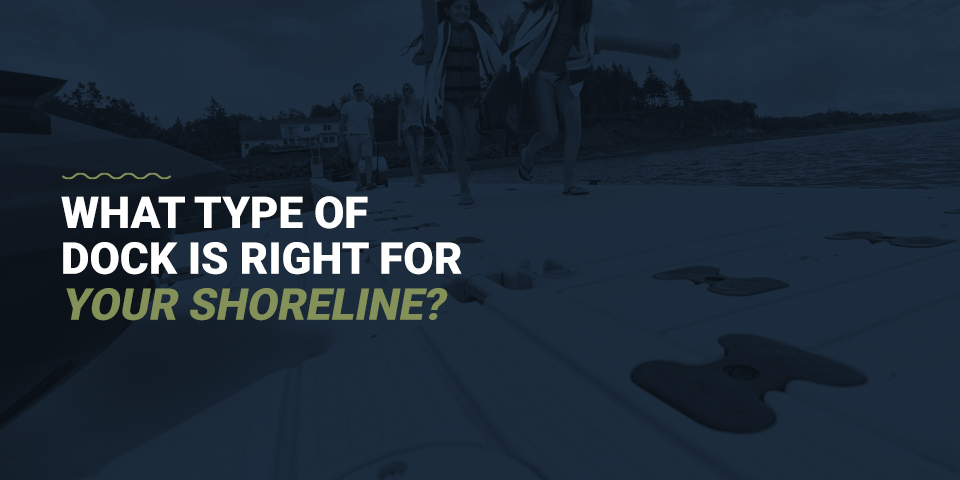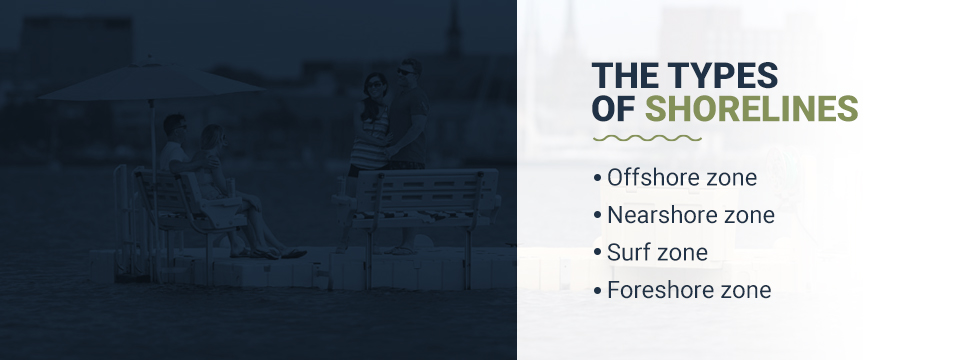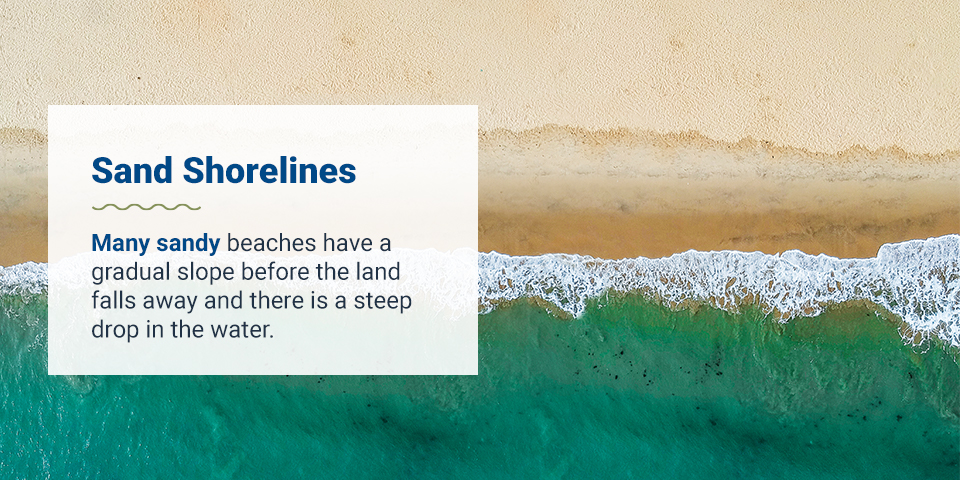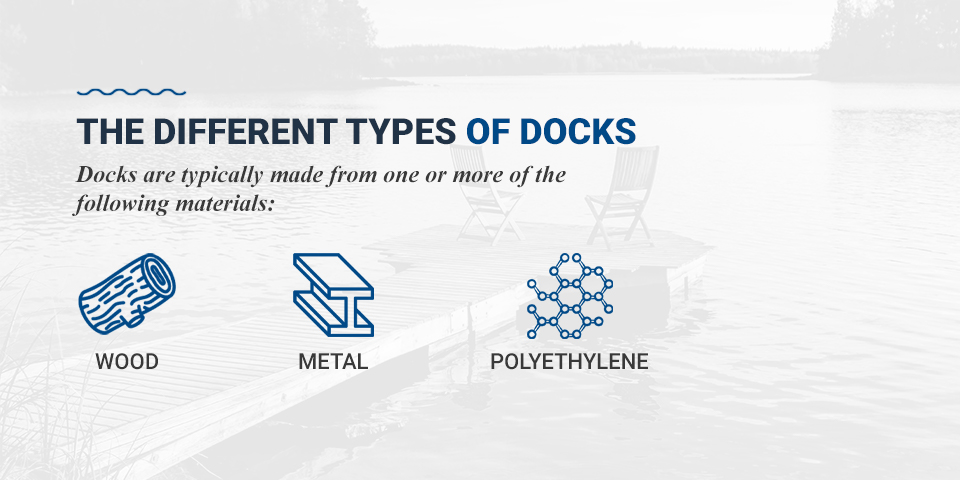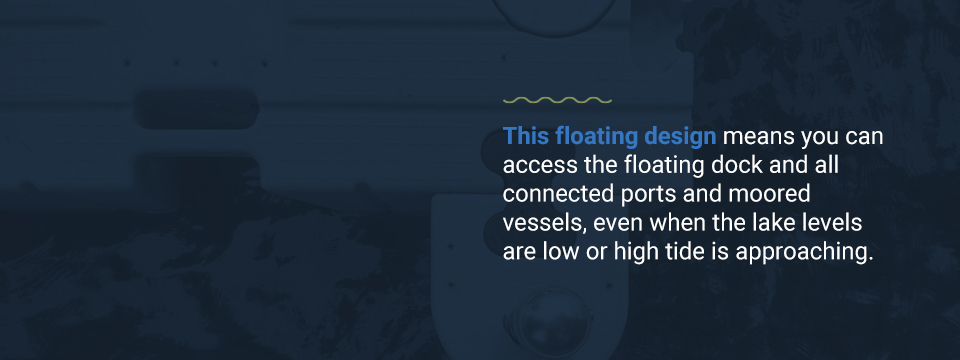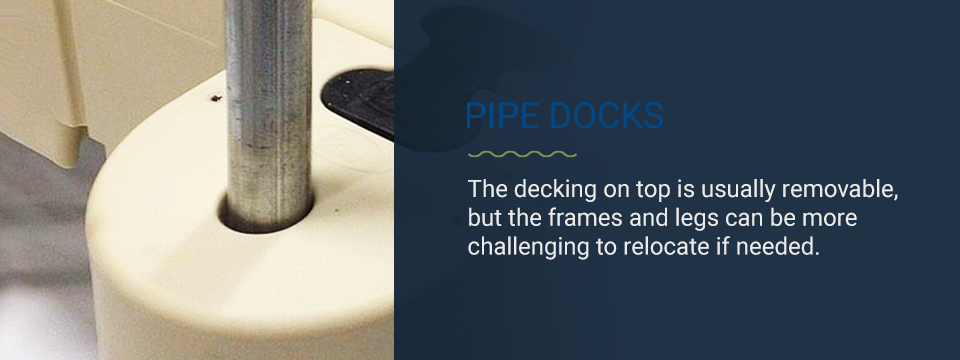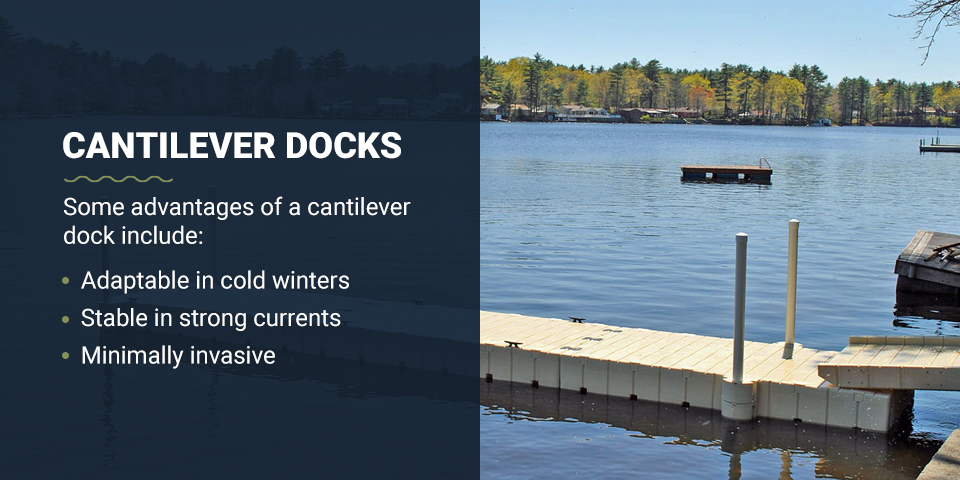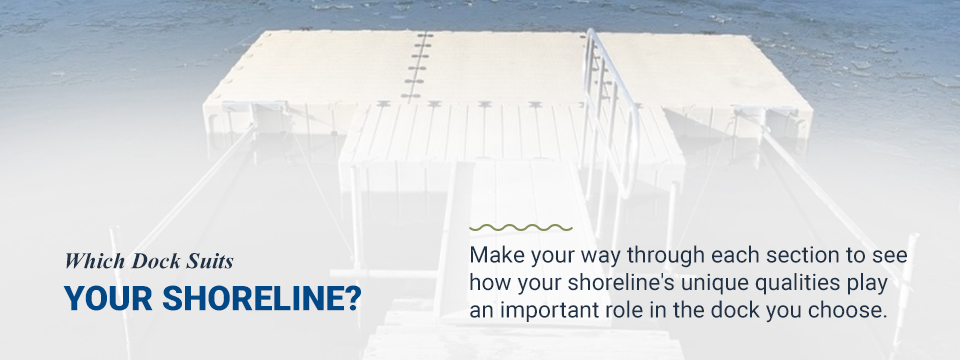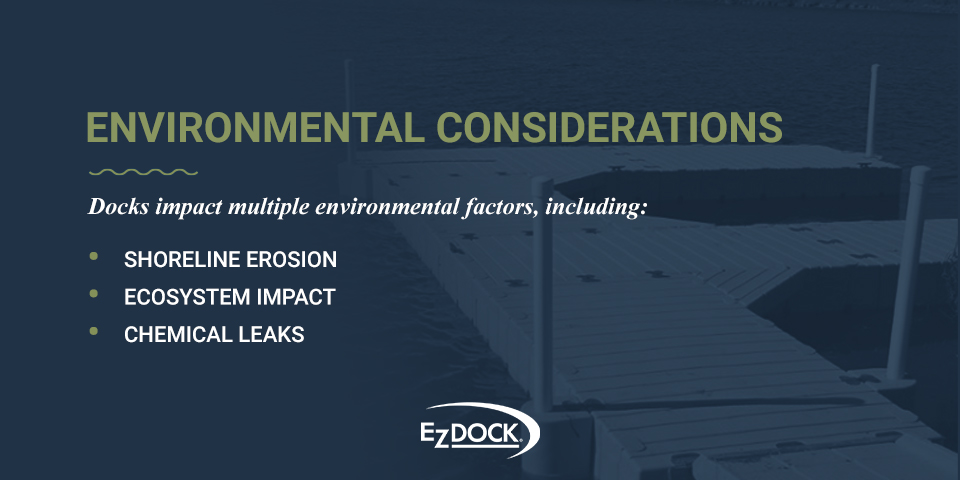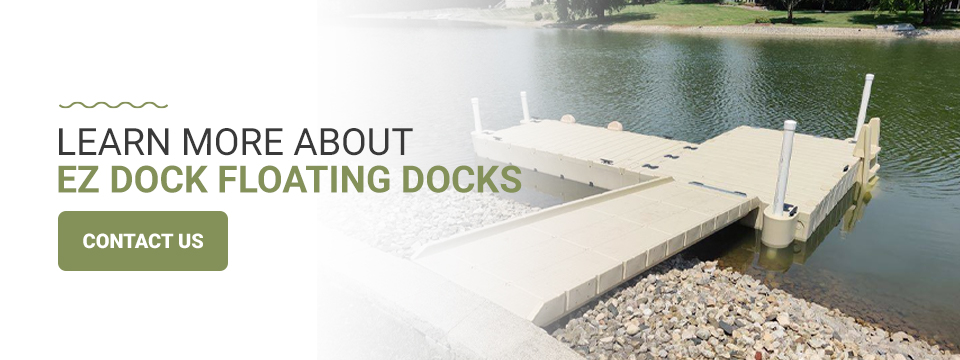Filters
What Type of Dock is Right for Your Shoreline?
Though shorelines look calm and picturesque from a distance, they are bustling with activity. This is where natural and incidental waves, gravitational tides, currents, land vegetation and marine ecosystems collide and exist in a cycle that is often co-dependent. Every shoreline is different, depending on the type of water you’re in, the surrounding environment and the depth of the water below.
You will want to consider many factors before installing your dock on the shore. Learn more about the different types of docks available to choose the best one for your property.
Read the full article or jump to a specific section:
- The Types of Shorelines
- The Different Types of Docks
- Which Dock Suits Your Shoreline?
- Learn More About EZ Dock Floating Docks
The Types of Shorelines
“Coastline” is a general term for an area where land meets water. A shoreline, which is the exact place where water, tides and land all meet and interact, is part of a more extensive coastline. Shorelines and coastlines exist on any body of water, including oceans, rivers, lakes and ponds. Shorelines contain several different zones, each one easily affected by external intrusions, like dock and piling placement:
- Offshore zone: The offshore zone is located below the water’s surface but not so deep that the ecosystem is inactive and not impacted by above-surface intrusions.
- Nearshore zone: The nearshore zone includes the upper and lower shoreface, where rocks are deposited. The area is prone to wave movement.
- Surf zone: The surf zone is the part of the coastline where the waves break.
- Foreshore zone: The foreshore zone overlaps with the surf zone and is both wet and dry, depending on the time of day, tide and similar conditions. On an ocean shoreline, like at the beach, the foreshore zone is where the smooth sand is that you walk on in between waves.
While all shorelines contain these natural zones, other conditions vary. Rocks, sand and wetlands are common types of shoreline environments found on public and private waterfront property.
Rocky Shorelines
A rocky shoreline can contain large boulders, rocks, pebbles or a combination of the three. You’ll find them along lakes, oceans and rivers. Though these shorelines are usually very durable against natural erosion from waves and rain, vegetation is sparse — avoid removing or damaging any existing plant life while installing your dock. Do not displace the rocks on the shoreline, or you risk leaving it exposed to the elements and causing faster deterioration. If rocky conditions extend beyond the shore and beneath the water, it may be impossible to secure pilings or pipes in the lake bed. In this case, a floating dock would be the best option since it allows you to bypass the rocks embedded below.
The rocky shore also refers to a specific marine ecosystem that lives in the ocean’s intertidal zone. Most marine rocky shores are protected and are not permissible for building or dock installation because even small projects risk causing an adverse chain reaction on the rest of the ecosystem.
Sand Shorelines
Sandy shorelines are common across oceans, lakes and some riverfronts, and the sand type and quality vary across regions. Some sandy beaches have sand dunes, complex and sensitive geological formations that you should never disrupt while installing a dock.
Many sandy beaches have a gradual slope before the land falls away and there is a steep drop in the water. This depth change means many docks do well on sandy beaches as long as they have adequate pilings, ramps or gangways to bridge the shallow water and sandy shoreline. If the sand extends beyond the shoreline and into the water bed, you might have trouble installing pilings or other permanent fixtures.
Keep changing tides in mind and work with a specialist to determine the approximate water height during storms and surges and natural changes during high and low tide, so you can install your dock where it will always be accessible.
Wetland Shorelines
Wetlands — including both coastal wetlands on ocean coasts and inland wetlands near some lakes, marshes and ponds — are highly active, protected natural environments. They house numerous animals, insects, plants, fish and birds while balancing ecology and aiding global climate conditions by storing carbon naturally.
Due to the sensitive nature of these areas, the Environmental Protection Agency (EPA) has executive orders to minimize the destruction or degradation of these ecosystems, including dock placement. Check with your local environmental office or building officials to learn more about wetland preservation and construction limits.
The Different Types of Docks
Docks are typically made from one or more of the following materials:
- Wood: Both treated lumber and composite wood are standard dock options because they are cost-efficient, easy to find and adaptable. However, each type requires specific ongoing maintenance and considerations because wood is prone to splintering, rot and warping. For example, you have to ensure all treated lumber is safe for use in your lake or pond and doesn’t contain any harmful toxins that could release into the water if damaged. Composite decking is more costly but requires less maintenance. Most wood docks require regular staining and sealing to retain their integrity and appearance.
- Metal: Aluminum and steel are the most common metals for docks. Aluminum is not as cost-efficient as wood but requires less maintenance and upkeep. Aluminum is stable and will not splinter or rot, and is less prone to corrosion than steel. Steel docks offer unparalleled strength compared to aluminum and maintain their shape against harsh waves. For this reason, it also weighs more and may be more challenging to install.
- Polyethylene: Polyethylene is a heat-resistant, splinter-free and slip-resistant plastic. EZ Dock floating docks are constructed out of high-density polyethylene and filled with air chambers, making them very lightweight but stable on moving water. Polyethylene does not fade in the sunlight, requires no chemical treatments and usually comes clean during a heavy rainstorm. Polyethylene also lends itself to a modular design for ultimate versatility and customization, so you can adapt your dock to fit your specific shoreline shape.
Most docks fall into one of five types, regardless of what material they are made from.
Floating Docks
Floating docks do not need pilings or crib foundations and make no contact with the lake bed or ocean floor. Instead, they use steel tubes, barrels, foam-filled billets or built-in air chambers to stay afloat on fluctuating water. This floating design means you can access the floating dock and all connected ports and moored vessels, even when the lake levels are low or high tide is approaching. Many floating docks, including EZ Dock configurations, are modular, meaning you can mix and match the right pieces to create your desired length and shape.
You can pair modular floating docks with accessories, like EZ Launch® Residentials, swimming platforms, boat ports, guardrails or wheels for easy transportation. You can also anchor a floating dock for more stability if you’re installing it on rough waters or in a busy surf zone with unpredictable conditions.
Floating docks are ideal for:
- Deep water: While floating docks are the best choice for most water depths, they are often the only option for deep water, where pilings or cribs may be impossible or too expensive to install.
- Challenging bed conditions: If your lake, ocean or pond bed is rocky or filled with sticky mud, it might be challenging to install pilings or pipes. Floating docks offer a cost-efficient, contact-free solution that won’t interfere with the natural bed conditions. This minimally invasive design is also ideal for vulnerable ecosystems and biodiverse regions.
- Fluctuating water levels: Floating docks are perfect for tidal waters or lakes with fluctuating depths. However, you should anchor your floating dock in bodies of water that experience extreme waves.
If you live in a region with icy winters, floating docks are easy to remove and store for the season. They are safe to leave in the water year-round if you experience warm or mild winter temperatures.
Piling Docks
Piling docks are a type of fixed dock installed into the water bed by drilling large pilings into the floor and then assembling the dock and decking on top. Pilings are available in various sizes and are typically made of wood, concrete or steel, and sometimes require fiberglass inserts for additional support. You’ll often find piling docks as a part of a larger, permanent waterfront design, like marinas or campgrounds. They require stable, predictable water conditions, like calm lakes or ponds.
Piling docks are suitable if you want a fixed dock and experience one or both of the following:
- Warm winters: Because you cannot remove a piling dock for the season, you should only install them in regions or waterfronts that aren’t prone to ice build-up. Too much ice could damage the dock and require costly repairs or replacements.
- Strong currents: Once pilings are secured underwater, a piling dock will be structurally sound and stable, even during tides and strong currents.
Piling docks are a significant initial investment because they require a lot of heavy-duty materials and specialized installation. Once installed, they require regular inspections and maintenance to ensure pilings remain intact and decking does not come loose, get warped or rot. You must treat wooden pilings regularly to protect the caps from sun damage and boring insects.
Pipe Docks
Pipe docks, or standing docks, consist of a solid, framed platform resting on supportive pipe legs. The decking on top is usually removable, but the frames and legs can be more challenging to relocate if needed. Most pipe docks are designed with adjustable legs, so you can move the dock up and down depending on the season and changing water conditions. They offer stability and flexibility without the need for permanent installation.
Pipe docks are minimally invasive and allow the sun to shine on the floor beneath without inhibiting water flow. They might be the right choice for you if you need a dock that accommodates:
- Calm waters: Pipe docks provide a stable walking surface, but they are not the best fit for fluctuating water or strong waves that may render the dock inaccessible.
- Flexible cost: Though the total cost varies depending on the materials and length you choose, pipe docks are more cost-efficient than piling or crib docks and often more adaptable.
- Firm bed conditions: Pipe docks require stable bed conditions for structural soundness and are not feasible in very deep water.
Most pipe docks need to be removed or adjusted in the winter to avoid ice build-up.
Crib Docks
Cribs are large wooden foundations filled with rocks and topped with supportive wood or aluminum decking. They extend from the shoreline to create a sturdy fixed dock and require specialized installation. A crib dock might be the right choice for your property if you meet one or more of the following criteria:
- Permanent solution: Crib docks are costly and complex to install and challenging to relocate and remove. They are best suited for permanent or long-term usage on commercial, industrial or governmental properties.
- Frigid winters: Crib docks can withstand ice flow better than many docking alternatives but require frequent inspections and maintenance both during and before winter to ensure structural soundness. Replacements and repairs may be costly if needed.
- Shallow water: Since you cannot install a crib dock in deep water, they are a better fit for properties with shallow water and manageable bed conditions.
Because crib docks can disrupt natural ecosystems and inhibit water flow and sunlight, most local governments require environmental compliance and permits before installing one on your property.
Cantilever Docks
A cantilever dock is what many property owners choose when they want a stable, semi-permanent dock with more flexibility than a piling or pipe dock. These docks, sometimes called suspension docks, hang over the water like a drawbridge. To build a cantilever dock, you need strong cables and an anchoring system that attaches the drawbridge platform to your shoreline, where you will need to place a concrete pad, posts or similar platform to support the dock’s weight. Some designs require a winch and crank to raise and lower the dock as needed, making them a perfect solution for steep slopes that are otherwise inaccessible.
Some advantages of a cantilever dock include:
- Adaptable in cold winters: You can easily remove a cantilever dock from the water before winter ice without fully uninstalling or storing it — but keep in mind that most docks still require protection against snowfall and extreme temperatures, even when it’s not on the water.
- Stable in strong currents: Cantilever docks are a good solution for deep water with strong or unpredictable currents since you can place them anywhere with adequate shoreline support and draw them up whenever the water gets too rough.
- Minimally invasive: Cantilever docks have minimal contact with the water floor but may cause significant shoreline damage if not installed correctly — always work with a professional before making any shoreline changes.
Some of the most significant disadvantages of a cantilever dock design are the amount of resources and hands-on work required to maintain and adjust it throughout the year. Installation can also be challenging, especially if you don’t have a stable shoreline to support a cantilever design. In this case, you would need an engineer’s assistance to create an anchor point and hinge with strong connecting hardware.
Which Dock Suits Your Shoreline?
As you consider your docking preferences, budget and property needs, examine your shoreline. What environmental factors should you consider? What type of water are you building your dock on? What is the floor beneath the water like? Make your way through each section to see how your shoreline’s unique qualities play an important role in the dock you choose.
Environmental Considerations
The shoreline environment, including animals, natural formations, vegetation and underwater ecosystems, is a critical part of choosing where to place your dock and which type of dock to use. Docks impact multiple environmental factors, including:
- Shoreline erosion: Shoreline erosion is when sediment from your shoreline moves or washes away over time. While some shoreline erosion caused by wind, rain and waves is natural, premature erosion can occur during dock installation. Avoid removing natural rocks or vegetation to install your dock.
- Ecosystem impact: Many fish and plants live just beyond your shore, and they rely on regular sunlight and water flow to live and eat. These plants and animals are important members of your local environment, as they absorb many water pollutants, protect soil from premature erosion and support healthy, biodiverse waters. Floating docks and cantilever docks are the best options for minimizing environmental impact and not impeding water movement.
- Chemical leaks: Treated lumber can leak chemicals, like copper and arsenic, into the water when damaged. These chemicals are hazardous for the marine life living there and can be costly to remedy.
Water Depth and Quality
Consider the water just beyond your shoreline — is it freshwater or saltwater? How deep is it? Saltwater shorelines need a dock made from polyethylene or non-corrosive metal, like aluminum, that can withstand regular salt deposits. Most docks are suitable in freshwater, as long as you inspect and maintain them regularly.
If your water is very shallow, choose a dock with no water contact, like a piling or pipe dock. Deep water is more challenging to install pilings and pipes into and is better suited for floating or cantilever docks, depending on shoreline stability and whether you can commit to installing on-shore platforms or poles to support a cantilever design.
Bottom Conditions
Lake, river and pond beds and ocean floor conditions vary drastically, even along the same shoreline. Bottom conditions include:
- Sand
- Mud
- Silt
- Rock
- Clay
- Vegetation
Loose materials, such as sand, silt and mud, cannot support pilings or pipes and are better suited for floating docks, especially in deep water. If the water is shallow and the floor loose, a concrete pad or underwater platform might work if you have the budget and environmental approval to install one. Firm materials, like clay, are compatible with most dock types as long as water levels don’t change. Pilings and cribs may not work in rocky beds — choose a floating or cantilever dock instead. Avoid installing any permanent pilings, pipes or cribs in marine vegetation.
Learn More About EZ Dock Floating Docks
Docks are a necessary part of waterfront living. They provide a stable place to moor and launch boats and watercraft, and they make it easy to enjoy fishing, swimming and lounging by the water. Before installing a dock on your property, you must consider all shoreline and water conditions to determine which dock type and material are right for you.
Modular floating docks are often the best choice since they strike the right balance between adaptability, customization, stability and durability, making them a long-lasting investment for any waterfront.
Learn more about EZ Dock floating dock sections and dock accessories and contact a representative to request a quote today.

